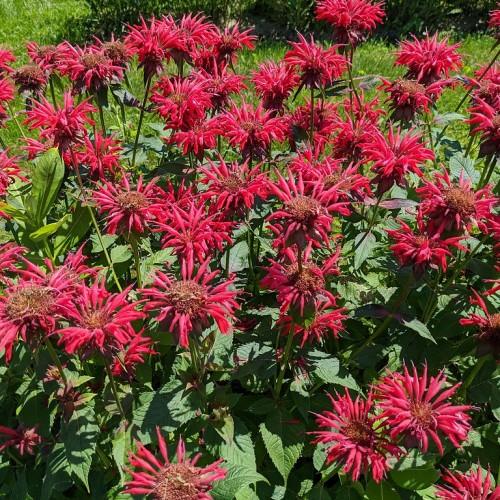
bee balm
Monarda didyma cvs.
Cycle:
Herbaceous Perennial
Watering:
Average
Hardiness Zone:
3
Flowers:
Flowers In Summer
Sun:
Full sun only if soil kept moist, Part sun/part shade
Soil:
Acidic, Humus rich, Well-drained
Fruits:
Fruits In Autumn Ready In Fall
Leaf:
Yes
Growth Rate:
High
Maintenance:
Low
Care Level:
Medium
watering
Bee balm (Monarda didyma cvs.) should be watered regularly and heavily for best performance. Water when the top inch of soil is dry, approximately once-twice per week. Waterings should be deep and thorough, allowing moisture to penetrate to the plant's roots. Take care not to overwater, as this can lead to root rot and other health problems. Be sure to test the soil to determine if the plant needs more or less watering, as different environmental factors can affect the amount of water needed to keep the bee balm healthy.
sunlight
Bee balm plants prefer full sun and grow best in locations that receive at least 6 to 8 hours of direct sunlight per day. In areas that experience hotter temperatures and strong sunlight, such as the South and Southwest U.S., it’s best to plant bee balm in a spot that gets morning sun and some afternoon shade. In cooler climates or those with foggy summer days, bee balm will enjoy full sun all day long.
pruning
Bee balm is best pruned in late summer or early fall. Pruning should be done when the plant is done flowering and has finished producing seed. For most varieties of bee balm, it is usually best to reduce the height of the plant by 1-third to 1-half. All dead, diseased or damaged stems should be removed and thinning should be done to allow better air circulation throughout the plant. Pruning will help promote new growth and should be done with a clean pair of garden scissors or a sharp knife.
FAQ
Is bee balm a native plant?
Yes, bee balm is a native plant. It is a member of the mint family and is native to much of North America. It is easy to grow and is popular in home gardens and butterfly gardens. The plant is often referred to as wild bergamot, horsemint and bee balm and typically blooms in late summer or early fall. Its fragrant flowers are attractive to bees, butterflies, moths and hummingbirds.
Should I plant bee balm in a container or on the ground?
Bee balm is an attractive, fragrant flowering plant that does well in both containers and planted directly in the ground. When planting bee balm in a container, be sure to choose a pot with plenty of drainage holes, and fill it with quality potting soil, or a blend of soil with compost. For best results, plant bee balm in direct sunlight, or in a spot where it will get at least six hours of bright, indirect sunlight. When planting bee balm directly in the ground, be sure to choose a location with well-draining soil and plenty of space for it to spread and thrive. Adding a layer of compost to the soil will increase drainage and help it thrive. No matter where you plant bee balm, be sure to water regularly, and remove spent flowers to encourage more blooms.
Could bee balm be used in a butterfly garden?
Yes, bee balm can absolutely be used in a butterfly garden. This herbaceous mint produces beautiful, vibrant flowers in shades of red, white, and pink that attract a variety of pollinators, including butterflies. In addition to its colorful flowers, bee balm has a strong scent that can be used to entice butterflies even more. To ensure that butterflies visit your butterfly garden, plant bee balm in a sunny location and keep the soil moist.
Is bee balm drought-tolerant?
Yes, bee balm is considered to be very drought-tolerant once established. It can withstand periods of dry weather and does not require frequent watering to survive. It does, however, respond best to wetter conditions, so watering regularly is recommended for optimal health. Bee balm is also suitable for growing in xeriscapes, which are areas with very low water requirements.
Should I deadhead bee balm flowers?
Deadheading bee balm flowers is definitely recommended. This simple process helps to encourage further bloom, as well as preventing the flowers from going to seed. To deadhead, simply use sharp scissors or pruning shears to cut off the stems that have already bloomed. Be careful not to prune too far back, as this could potentially damage the plant in the process. After deadheading, be sure to dispose of the cuttings away from the plant, to prevent the spread of disease.
Is bee balm annual or perennial?
Bee balm, also called Monarda, is an herbaceous perennial plant from the mint family. Bees and other pollinators are attracted to the vibrant colors and aroma of bee balm. The plant is easy to grow, but is usually only grown as a perennial in USDA hardiness zones 4-9. In colder zones, bee balm will die to the ground as winter sets in, but will return in the spring.
Could bee balm be used in herb gardens?
Yes, bee balm can be used in herb gardens. Bee balm is an attractive perennial herb that provides color and fragrant blossoms, which is beneficial to any herb garden. Bee balm also attracts pollinators such as bees and butterflies to the garden. It is easy to grow and care for and can be used in a variety of culinary and medicinal recipes. Bee balm is an ideal ornamental herb to include in any herb garden.
